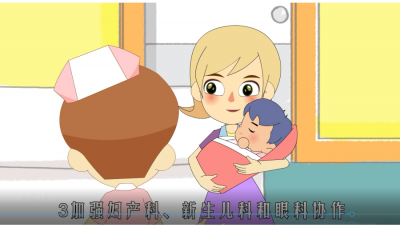Join a powerful, unprecedented alliance for better eye health for all.
Join IAPB-
Choose an alternate language here
Child eye health promotion was one of the major components of the Seeing is Believing CHEER Project which was conducted in multi-formats through multi-channels from community level to tertiary level in Shanxi China. Leaflets, booklets, and posters were distributed through clinics, schools and special events. Health talk videos were played on a continuous loop at clinics and during school screening.
The project worked with advertising agencies to design Behaviour Change Communication (BCC) materials and three key factors were taken into consideration:
The video agency advised the project to invite local pediatric ophthalmologists to talk about the key messages in early detection, treatment of common eye diseases such as strabismus, congenital cataracts and eye injuries. Optometrists were invited to speak about electronic products and outdoor activities and myopia. This helped to build trust between parents and eye care professionals. A brochure on common eye diseases was developed with coloured cartoon pictures and captions, which school children liked. The advertising agency helped with colour contrast, font size and the layout of printing BCC materials. Together with another consortium INGO and local partners, a black and white leaflet and black T-shirts with ten key messages were printed about cortical visual impairment were developed for children with low vision to have better contrast.
 2) Focusing on the target audience
2) Focusing on the target audienceChildren, parents, and schoolteachers are critical for prevention of refractive error, eye injury and ROP. Orbis International worked with the video agency to design child-friendly cartoon videos. Sand painting was used in one of the videos. The video agency staff had lengthy discussions with eye care professionals on how to make the video simple and attractive to children and parents. Eye care professionals provided raw materials and case studies while the video agency adapted it by removing any jargon. The prototype was tested among health professionals, children and non-health people. Two cartoon videos were designed for the prevention of ROP. One was for prenatal health education to parents, early screening and follow-up by targeting the public. The other video targeted medical professionals to highlight the multi-disciplinary collaboration between the obstetric department, NICU and the eye department.
In the early phase of the project, the video agency insisted on making long videos even though the contract fee was fixed regardless of the length. The first video on general child eye health was 11 minutes with pictures they shot during school screening and in hospitals. The second video on eye diseases was 9 minutes. These videos could not be shared through social media/WeChat so a large audience was missed. After some discussion with the video maker, it was agreed to make mini-movies with key messages only and limit the length to 4 minutes for ocular injuries and 2 minutes for ROP. These were widely shared and liked by the public reaching over a million people.
Author: Guan Chunhong, [email protected]
Photo submitted by Keith Kalu, to the IAPB World Sight Day Photo Competition.